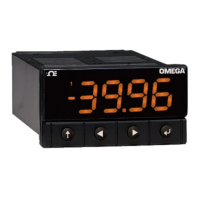PLATINUM
TM
Series User’s Guide
PLATINUMTM Series Navigation
2. PLATINUM
TM
Series Navigation
Figure 2.1 – PLATINUM
TM
Series Display (CN8DPt Shown)
2.1 Description of Button Actions
The UP button moves up a level in the menu structure. Pressing and holding the UP button
navigates to the top level of any menu (oPER, PRoG, or INIt). This can be a useful way of
reorienting yourself if you get lost in the menu structure.
The LEFT button moves across a set of menu choices at a given level (up in the Section 4
menu structure tables). When changing numerical settings, press the LEFT button to make
the next digit (one digit to the left) active.
The RIGHT button across a set of menu choices at a given level (down in the Section 4
menu structure tables. The RIGHT button also scrolls numerical values up with overflow to
0 for the flashing digit selected.
The ENTER button selects a menu item and goes down a level, or it enters a numerical
value or parameter choice.
2.2 Menu Structure
The menu structure of the PLATINUM
TM
Series is divided into 3 main Level 1 groups, which are
Initialization, Programming, and Operating. They are described in Section 2.3. The complete menu
structure for levels 2-8 for each of the three Level 1 groups is detailed in Section 3.1, 3.2, and 3.3. Levels
2 through 8 represent sequentially deeper levels of navigation. Values with a dark box around them are
default values or submenu entry points. Blank lines indicate user-provided information. Some menu
items include links to reference information elsewhere in this user manual. The information in the Notes
column defines each menu choice.
2.3 Level 1 Menu
Initialization Mode: These settings are rarely changed after initial setup. They include
transducer types, calibration, etc. These settings can be password-protected.
Programming Mode: These settings are frequently changed. They include Setpoints,
Control Modes, Alarms, etc. These settings can be password-protected.
Operating Mode: This mode allows users to switch between Run Mode, Standby Mode,
Manual Mode, etc.
Omega Engineering | www.omega.com

